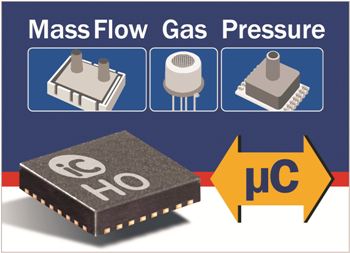The new iC-HO device is a universal sensor interface for the assembly of flow, gas, and pressure sensors.
 iC-HO universal sensor interface device
iC-HO universal sensor interface device
The following functional units are included in the device: a configurable signal conditioner, a fast analog/digital converter, configurable current sources, temperature drift compensation, digital sensor configuration, an SPI µC interface, adjustable linearization, and a ratiometric, differential analog output. All of these functions are housed on a monolithic chip in a QFN32 package measuring 5 mm x 5 mm.
Resistive mass airflow sensors are driven by iC-HO using two identical reference currents so that the voltage difference conditioned by the programmable amplifier (PGA) can be measured and processed in a digitized form. The necessary temperature control unit is fully integrated in the chip.
With gas sensors a variable tracking controller for two temperatures with a configurable temporal sequence is used. Differential, synchronous recording of the sensor resistance can be configured. The heating controller monitors the sensor temperature according to the profile using the energized heating resistor. It is not necessary to electrically split the heating resistor and sensor resistor on a sensor MEMS element as iC-HO electrically separates the heating and measurement units.
With pressure sensors, for example, iC-HO provides differential measurement on a resistor measuring bridge as a half or full bridge. By performing an additional measurement the sensor temperature curve can be suitably compensated for. It is also possible to supply the measuring bridge using a constant current source in place of a voltage.
For flow and gas sensor applications a heating system with a control circuit is also required in addition to the sensor conditioning unit. An on-chip heating controller drives a sensor heating resistor through additional differential sensor inputs and a digital PI controller with D/A conversion. The PI controller can exercise both relative and absolute control over the temperature. A maximum heating current can be specified to protect the external MEMS sensors.
Gain and offset correction of the programmable amplifier (PGA) can be automatically tracked for the purpose of sensor temperature compensation. The fast, 11-bit A/D converter can either process the measurement values directly or as the difference between two conversions.
The measurement values are output through a ratiometric, differential analog output. Alternatively, the SPI interface implemented for chip configuration can be used to scan the measurement value and system state through a microcontroller.
Error states and error thresholds can be defined to monitor and diagnose the sensor and chip. These are output through an open collector switching output or the SPI interface.
iC-HO has an internal reference voltage and can output internal analog signals and the bias current to standard signal pins for calibration.
iC-HO operates from 4.5 V to 5.5 V within a temperature range of -25°C to +104°C. At just 5 mm x 5 mm x 1 mm the 32-pin QFN package is extremely compact and has a very good heat dissipation.
The design-in process is supported by ready-to-operate demo boards and software for evaluation with a PC.
Further information is available at http://www.ichaus.com/iC-HO.